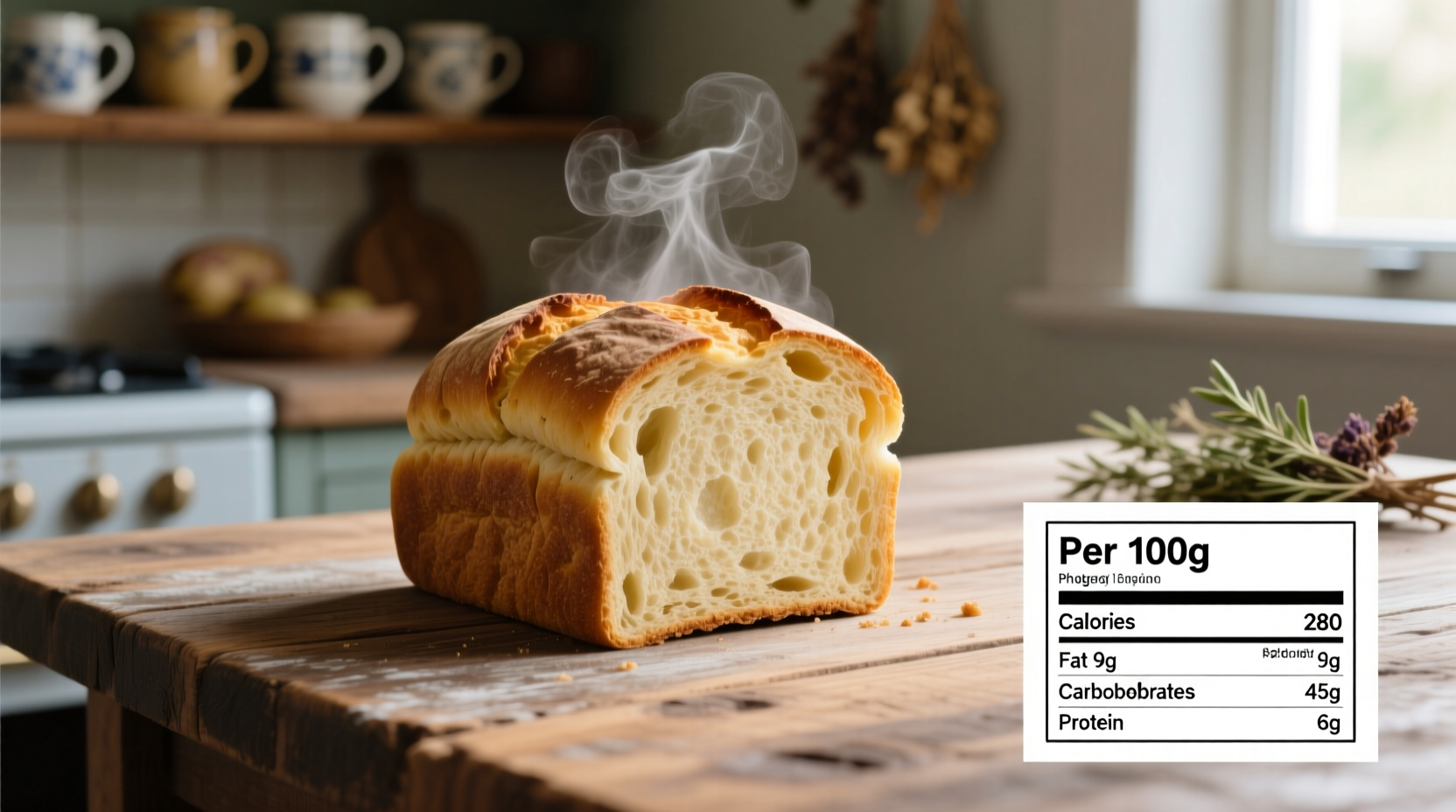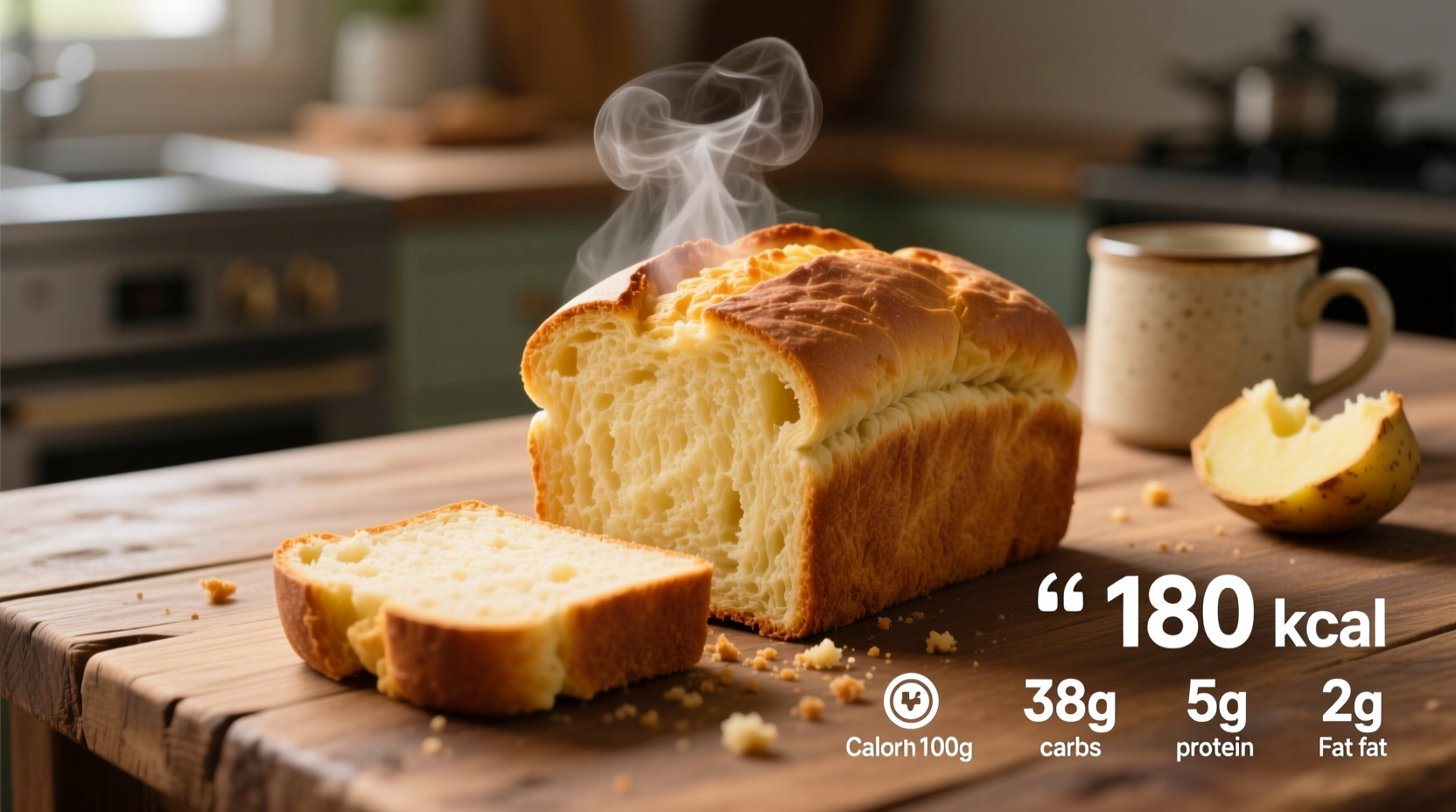Discover exactly what's in your potato bread and how it compares to other bread options. This comprehensive guide delivers precise nutritional information, practical usage tips, and science-backed insights to help you make informed dietary choices.
Nutritional Breakdown of Potato Bread
Understanding the complete nutritional profile of potato bread helps you incorporate it wisely into your eating plan. Unlike basic white bread, potato bread contains additional nutrients from the potato component, though calorie counts remain relatively similar.
According to USDA FoodData Central, a standard 28g slice of commercially prepared potato bread provides:
| Nutrient | Amount per Slice (28g) | % Daily Value* |
|---|---|---|
| Calories | 75 | 4% |
| Total Fat | 1.5g | 2% |
| Sodium | 140mg | 6% |
| Total Carbohydrates | 14g | 5% |
| Dietary Fiber | 1g | 4% |
| Sugars | 1g | - |
| Protein | 3g | 6% |
*Percent Daily Values are based on a 2,000 calorie diet. Your daily values may be higher or lower depending on your calorie needs.
The potato content adds subtle nutritional advantages over standard white bread, including small amounts of potassium and vitamin C. However, these amounts are minimal in commercially prepared versions where potato content is often just 5-10% of the total ingredients.
How Potato Bread Compares to Other Bread Options
When evaluating potato bread calories, context matters. Here's how potato bread stacks up against common alternatives:
| Bread Type | Calories per Slice (28g) | Key Nutritional Differences |
|---|---|---|
| Potato Bread | 70-80 | Slightly higher potassium, softer texture |
| White Bread | 65-75 | Lower fiber, fewer micronutrients |
| Whole Wheat Bread | 70-85 | Higher fiber (2-3g), more B vitamins |
| Rye Bread | 80-90 | Higher fiber, denser texture |
| Sourdough | 75-85 | Lower glycemic impact, probiotic benefits |
This comparison shows that potato bread calories fall within the standard range for enriched breads. The primary difference lies in texture and subtle flavor rather than significant nutritional advantages.
Portion Control Guidance for Potato Bread
Many people unknowingly consume multiple servings when eating bread. For accurate calorie tracking with potato bread:
- Measure portions using a food scale - one standard slice equals 28 grams
- Check packaging for serving size, as artisanal or bakery-style slices often weigh 40-50g (100-120 calories)
- When making sandwiches, account for both slices (140-160 calories total)
- Homemade versions vary significantly based on potato-to-flour ratio
Registered dietitians recommend limiting bread portions to 1-2 slices per meal for most adults following standard calorie guidelines, which translates to 70-160 calories from potato bread per eating occasion.

Health Considerations and Dietary Context
While potato bread calories resemble other enriched breads, its nutritional context matters for different dietary approaches:
For Weight Management: Potato bread fits within most calorie-controlled plans when consumed in appropriate portions. Its slightly higher moisture content from potatoes may provide marginally better satiety than standard white bread.
For Diabetics: Like most refined grain products, potato bread has a moderate glycemic index (around 70). Pairing it with protein or healthy fats can help moderate blood sugar response.
For Gluten-Free Diets: Traditional potato bread contains gluten. However, many gluten-free bread recipes incorporate potato flour as a primary ingredient, creating a different nutritional profile (typically higher in calories and fat).
Research published in the Journal of Food Science indicates that breads incorporating potato components show slightly improved texture retention during storage compared to standard wheat breads, which explains their popularity in commercial baking despite minimal nutritional advantages.
Practical Usage Recommendations
Maximize the value of potato bread in your diet with these chef-tested strategies:
- Toast for enhanced flavor: Light toasting concentrates flavors, allowing you to enjoy smaller portions
- Create balanced sandwiches: Pair with lean proteins and vegetables to create nutritionally complete meals
- Use in moderation: Substitute for higher-calorie sandwich bases like croissants or brioche
- Check ingredient lists: Some commercial versions add sugar or fats that increase calorie density
- Consider homemade options: Control ingredients to create versions with higher whole grain content
Professional bakers note that authentic potato bread recipes use potato water or dehydrated potato flakes rather than mashed potatoes, which helps maintain proper dough structure while adding distinctive flavor and softness.
Frequently Asked Questions
How many calories are in homemade potato bread compared to store-bought?
Homemade potato bread typically contains 80-100 calories per slice (28g) compared to 70-80 calories for commercial versions. The difference comes from richer ingredients like butter, eggs, and higher potato content in homemade recipes. Artisan bakery versions often fall between these ranges at 75-85 calories per slice.
Is potato bread lower in calories than regular white bread?
Potato bread and white bread have nearly identical calorie counts, with both averaging 70-80 calories per standard slice. The primary differences are texture and subtle flavor variations rather than significant nutritional distinctions. Some commercial potato breads may contain slightly more calories due to added fats that enhance moisture retention.
Does potato bread have more carbohydrates than other breads?
Potato bread contains approximately 14g of carbohydrates per slice, which is comparable to white bread (13-15g) and slightly less than whole wheat bread (15-17g). The potato component doesn't significantly increase carb content as it replaces some of the flour rather than being added on top of standard bread ingredients.
Can potato bread fit into a weight loss diet?
Yes, potato bread can fit into a weight loss diet when consumed in appropriate portions (1-2 slices per meal). At 70-80 calories per slice, it falls within standard carbohydrate allowances for most calorie-controlled plans. For better results, pair potato bread with protein and fiber-rich ingredients to increase satiety and create balanced meals that support weight management goals.











 浙公网安备
33010002000092号
浙公网安备
33010002000092号 浙B2-20120091-4
浙B2-20120091-4